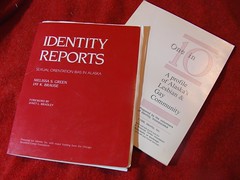(Posted originally on Henkimaa.com.)
 In the 1980s, the nonprofit organization Identity, Inc. conducted two major research efforts to profile Alaska’s lesbian and gay community and to document sexual orientation bias in Alaska. The studies which resulted have gained relevance again with the introduction in the Anchorage Assembly in 2009 of ordinance AO 2009-64:
In the 1980s, the nonprofit organization Identity, Inc. conducted two major research efforts to profile Alaska’s lesbian and gay community and to document sexual orientation bias in Alaska. The studies which resulted have gained relevance again with the introduction in the Anchorage Assembly in 2009 of ordinance AO 2009-64:
- One in Ten: A Profile of Alaska’s Lesbian & Gay Community by the volunteers of Identity, Inc. (1986)
- Identity Reports: Sexual Orientation Bias in Alaska by Melissa S. Green and Jay K. Brause (1989)
To make the studies more easily available, Identity has granted permission to scan the documents in and make them available on the Internet and to the Anchorage Assembly. Find both reports here.
Some of the relevant findings from both reports:
Of the 734 respondents to One in 10 (statewide survey in 1985):
- 61% reported having been victimized by violence and harassment while in Alaska because of their sexual orientation;
- 39% reported having suffered from discrimination in employment, housing, and loans/credit; and
- 33% reported having suffered from discrimination because of sexual orientation from services and institutions.
From the “Closed Doors” component of Identity Reports (based on a 1987 survey):
- 31 percent of the 191 employers in the survey said they would either not hire, promote, or would fire someone they had reason to believe was homosexual.
- 20 percent of the 178 landlords in the survey said they would either not rent to or would evict someone they had reason to believe was homosexual.
From the “Prima Facie” component of Identity Reports (based on interviews and documentary evidence through 1987)
- 84 actual instances of antigay bias, discrimination, harassment, or violence (including three murders) were recorded involving 30 men and 21 women in the Municipality of Anchorage (64 cases), the City and Borough of Juneau (4), the Fairbanks North Star Borough (6), and 10 other localities in Alaska (10).
- Victims were predominately gay men or lesbians, but also included heterosexuals who were erroneously assumed to be gay or lesbian.
- Of the 42 cases of employment, housing, public accommodations, and business practices discrimination from personal (as opposed to documentary) testimony, 32 were evaluated by a former intake investigator with the Alaska Human Rights Commission as being jurisdictional under AS 18.80 (Alaska’s human rights statutes) if AS 18.80 had included “sexual orientation” as a protected class.
As I testified before the Anchorage Assembly on June 16, 2009, other testimony that had already been brought forward of actual cases of discrimination shows that sexual orientation discrimination, as well as gender identity discrimination, is still going on today. And I said that only two days into the testimony, which ended up taking up several hours over six different Assembly meetings, and including not only testimony from lesbians, gay men, bisexuals, and transsexual or transgendered people who had been discriminated against, but also testimony from ordinance opponents, many of whom made clear their prejudice and intention to discriminate. In fact, on the same night I testified, one man confessed to having physically assaulted a man who had (nonviolently) propositioned him — violently enough that he put the man in the hospital. And ordinance opponents applauded him!
Yet on August 11, 2009, in voting against the anti-discrimination ordinance AO 2009-64, two Assembly members — Chris Birch and Bill Starr — claimed that they could find no sign of “invidious” or “widespread” discrimination in Anchorage. Another Assembly member — Dan Coffey — constructed a resolution (which failed) for a task force to study the issue further, apparently because he also felt there wasn’t enough data. (Or not enough of the sort he wanted, perhaps.) Assembly Chair Debbie Ossiander described how she sought out data on sexual orientation and gender identity discrimination from the Anchorage Equal Rights Commission and the Alaska Human Rights Commission, only to find that there wasn’t any — because neither characteristic was covered by existing law. To Ossiander, that seemed to indicate that there was no data on discrimination — despite my testimony; despite my having provided every member of the Assembly with copies on CD of both reports, as well as a hard copy for each of them of the “Prima Facie” component of Identity Reports; and despite the testimony of other Anchorage residents on discrimination that they had actually experienced.
Take a look at the data for yourself.
In the meantime, thank you again to the seven Assembly members — Patrick Flynn, Sheila Selkregg, Jennifer Johnston, Mike Gutierrez, Matt Claman, Elvi Gray-Jackson, Harriet Drummond — who voted with the evidence, and passed an ordinance to prohibit sexual orientation and gender identity discrimination in Anchorage.
— Melissa S. Green
August 13, 2009
Posts at Henkimaa.com which discuss data from the two Identity studies:
- 5/13/09. “Channel 11 interview, part 2 (the full story).” Includes both the write-up in Identity Reports, and the full story, of my being fired from the Sears Mall branch of the Book Cache bookstore in 1984 after a coworker told my employers I was a lesbian.
- 6/2/09. “My letter to the Anchorage Assembly.”
- 8/7/09. “Delay by ‘task force’: My testimony to the Anchorage Assembly.” Text of my June 16, 2009 testimony.
Follow the tags to other posts at Henkimaa.com about One in Ten and Identity Reports.
